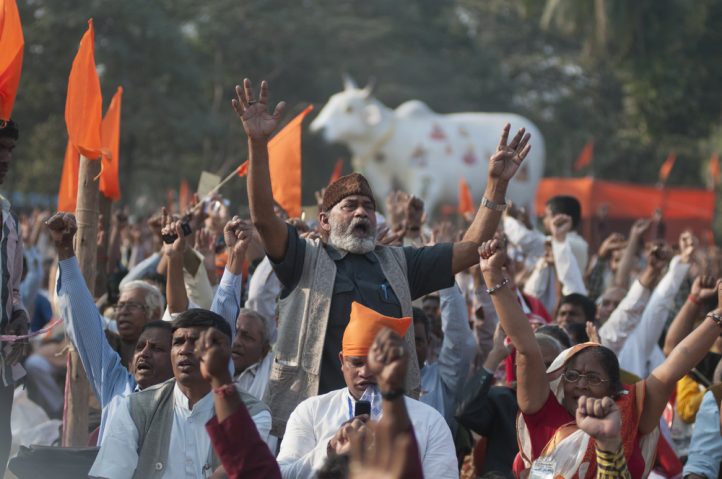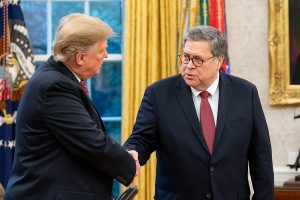by John Feffer
In the beautiful and terrifying novel The City of Devi, communal hatreds escalate in India and Pakistan until the two countries feel compelled to threaten each other with nuclear weapons. At least, it starts out as a threat. Pakistan vows to take out Mumbai, and India will level Karachi. But everyone involved knows that nuclear war doesn’t really work that way.
“Nuclear bombs are like potato chips,” the author Manil Suri writes, “nobody can stop at just one. Every scenario predicts that a country under attack will launch all its weapons at once to avoid losing them.”
The populations of the two cities panic. A great exodus takes place as residents flee by car, by train, even by foot, and the wealthy try to snag the last berths on the outgoing ships. A woman and a man traverse this chaos in search of the object of their affections: it’s love in the soon-to-be-ruins. They hope against hope that the bombs won’t fall. And then an accident happens, as they so often do, and Pakistan mistakenly launches one missile at Mumbai. And India retaliates with four strikes on Karachi.
One of the characters in the novel, Mr. Cheerio, assesses the damage from some faraway perch via short-wave radio:
You might think me cold-blooded, but this is one of the best possible outcomes in terms of human cost. Only one or two cities struck, and that too almost empty — can you imagine the miniscule probability? There was bound to be an exchange, either now or in the future — things had gone too far. Every war-game simulation I’ve ever seen predicted results more final, more unthinkable, than how this seems to have played out.
Manil Suri is a mathematician, as well as a novelist, so he knows about probabilities. The devastation wrought by the nuclear exchange in The City of Devi is terrible — the incineration, the radiation, the environmental damage. But a roll of the nuclear dice could have produced much worse.
Those worse-case scenarios are what India and Pakistan — and the rest of the world — have been recently contemplating. After all, the most likely locus of nuclear war is not on the Korean peninsula. It’s not across the old Cold War divide in Europe. It won’t involve Israel’s secret cache of H-bombs.
If nuclear war comes, it will happen because of a calculation or miscalculation by India or Pakistan. There are fanatics on both sides who care only about vanquishing their rival by any means necessary.
Unlike in a novel, however, a catastrophic denouement to the current conflict is not inevitable.
Tit for Tat
India and Pakistan have been engaged in a tug-of-war over the territory of Kashmir since the very separation of the two countries that followed independence in 1947. China, too, has gone to war with India over its portion of the territory. Kashmir is the only place in the world where three nuclear powers have a border dispute.
In the most conflict-ridden part of the region, the Jammu and Kashmir region of northern India, a separatist movement inspired by Islamic radicalism squares off against about a half a million Indian troops. Three wars between India and Pakistan, plus the skirmishes that have taken place in between, have claimed around 70,000 lives.
Last month, as part of the insurgency against Indian control of this part of Kashmir, a suicide bomber went after a unit of Indian soldiers, killing 40. In response, India launched its first cross-border attack on Pakistan in nearly 50 years when it bombed a presumed militant encampment. Pakistan responded by dropping some bombs inside Indian territory. Neither attack seems to have destroyed much of anything, though India claims otherwise.
In a subsequent dogfight, Pakistan shot down an Indian jet fighter and captured the pilot. In a hopeful move, Pakistan returned the pilot to India “as a gesture of peace.” However, Indian Prime Minister Narendra Modi reciprocated with a threat: the first attacks were just practice, he warned, “now we have to make it real.”
A new round of attacks, however, was not forthcoming. Pakistan has promised to go after Islamic militancy and has even taken some steps in that direction. As The Economist put it, “Relations between India and Pakistan are returning to the normal huffy disdain after a week of military brinkmanship.”
It’s a mistake, however, to think that all is well on the subcontinent.
Future Sparks
The political party of Narendra Modi subscribes to a virulent version of Hindu nationalism. He largely soft-peddled this nationalism four years ago when the BJP won a commanding parliamentary majority. Once in power, however, Modi has fallen back on what worked for him as the chief minister of Gujarat: inflaming the passions of his more militant followers. Writes Max Frost in The National Interest:
Indian politicians have normalized hardline Hindu nationalism through draconian cow protection laws, the renaming of cities with Muslim names, and the appointment of extremist Hindu nationalists to powerful positions. These shifting priorities explain Modi’s 2017 appointment of a firebrand Hindu monk, Yogi Adityanath, as chief minister of India’s most populous state. Adityanath has claimed that Hindus are “preparing for religious war” and has called Muslims “a crop of two-legged animals that has to be stopped.”
Hindu nationalists have also taken aim at the Indian constitution, which provides Muslim-majority Jammu and Kashmir province the special status of greater autonomy. So, for instance, Indian citizens from other parts of the country can’t buy property in the province, which helps it retain its Muslim majority. Top BJP officials, however, want Article 370, the offending part of the constitution, repealed.
Indian elections take place next month, and Modi is campaigning for a second term. Because of the myriad problems facing the country, he was looking at a significant backlash at the polls. The aggressive response to Pakistan, however, has boosted his electoral fortunes. According to political analyst Yogendra Yadav, Modi’s party could have lost at least 100 seats in the upcoming election, but now, “the impression is things have improved for BJP.”
Pakistan has promised to go after suspected militants on its territory. But Prime Minister Imran Khan is in a difficult position. The country is practically bankrupt, and he has had to go begging to Saudi Arabia in particular for assistance. He has also taken a more accommodationist approach to the Taliban as a way to resolve the war in Afghanistan and reduce cross-border problems. The Trump administration, meanwhile, has not shown Pakistan much love. China has much better relations with Islamabad, but has been quite selective in pressuring its ally to crack down on extremism. China views some extremist factions, for instance, as useful for cementing Beijing’s influence in Afghanistan and hobbling its major challenger in the region, namely India.
As The New York Times notes, the Trump administration is in no position to act as a mediator, given the president’s obvious preference for India, “where he has pursued business interests.” Indeed, the subcontinent has emerged as a locus of U.S.-China conflict, as Beijing has pushed forward with its Belt and Road initiative in Pakistan and the United States is pressuring India to join its containment strategy against Iran.
India and Pakistan may well shape up to be the modern counterpart to Cold-War-divided Germany. Kashmir, then, is the new Berlin: divided, tense, full of intrigue. The two superpowers have found two very dangerous proxies to engage in shadow play.
The military confrontation, meanwhile, has developed its own dynamic. As Arzan Tarapore writes at War on the Rocks:
India demonstrated a new appetite for imposing costs on Pakistan, and especially for crossing thresholds and accepting risk. Its actions probably still won’t deter Pakistan, though they will make the next crisis more dangerous. India may now assess that henceforth it can strike its neighbor, absorb a proportionate Pakistani retaliation, and safely de-escalate later in a crisis. But with Pakistan now more concerned about its own deterrent, this crisis may induce both sides to take riskier action next time.
Such riskier actions could escalate all the way to the nuclear level. And the consequences of a nuclear exchange would be considerably worse than what’s depicted in The City of Devi. If the two sides only use only a portion of their nuclear arsenals, it would kill millions of people on the subcontinent and also have a devastating impact worldwide. A partial nuclear winter would settle upon the planet: the resulting hunger, drought, and disease would kill as many as 2 billion people.
Now that the acute crisis has passed, regional actors have to use this reprieve to defuse the world’s most dangerous nuclear faultline. Those efforts have to begin with Kashmir. Fortunately, the difficult task of working out a joint resolution to the problem has already been done, back in the mid-2000s. As Ahmed Rashid points out:
Indian and Pakistani envoys agreed to make the Line of Control, the heavily militarized border between the Indian and Pakistani-controlled portions of Kashmir, irrelevant by giving the Kashmiris the right to free movement and trade across the line. They agreed upon providing autonomy to Kashmir’s subregions and drawing down forces as violence receded. They also agreed to establish a body of Kashmiris, Indians, and Pakistanis, vaguely described as a “joint mechanism,” to oversee the political and economic rights of the Kashmiris on both sides of the line.
Khan seems amenable to revisiting this deal; Modi will not budge until after the elections. The missing ingredient at this point is pressure from outside the subcontinent. Here, the cluelessness of the Trump administration and the unraveling U.S.-China relationship serve as significant obstacles.
But maybe India and Pakistan will show more sense than their respective backers. These are ancient civilizations that have weathered many previous storms. Now they just have to team up to avoid a nuclear winter.






Very sorry to see that Karachi and Mumbai have been singled out to be targeted by the two countries. This is ironic and dangerous.
Ironic- because the Kashmir issue has more supporters in the North of Pakistan than in Karachi – I am guessing here but I would think the same is true of Mumbai.
Dangerous, since many in Pakistan would be quite happy to see Karachi taken off the face of the earth. If they find out that the Indian response to a nuclear attack from Pakistan would be taking out Karachi, this would only encourage them to initiate one!!!!!!!!
My suggestion to the warmongers on both sides -please spare these two cities- they are the refuge of millions of poor people who go there to eek out a living, the Central and the provincial governments have no interest in its development; the infrastructure is broken , the garbage does not get picked up. The city just tries to survive despite all this. Further, Karachi has no power, control or for that matter representation in the military establishment.
Again to the warmongers – If you have to fight then please do so amongst yourselves – spare the poor the disposed and the innocent!!!!
A very dreadful scenario indeed. Nuclear war would be the worst that could happen to any region and/or even to humanity. For the sake of survival of humankind or a fraction of it every measure should be taken and every effort mounted by all to lay the ghost of nuclear war to rest for ever. The very possession of these weapons fly in the face of assumed rationality which we all are so proud of. Billion and billions are going down the nuclear drain which could have been better spent for the welfare of ordinary people.
Agree completely.
The most ridiculous thing about the so called core issue between India and Pakistan – the Kashmir issue- is that the interests of both, Pakistan and India are identical. Let me explain.
Both India and Pakistan want to keep control over their parts of Kashmir. Both have hopefully realized after three wars that they cannot get the other part.
Two major opinion surveys conducted on both sides of border in Kashmir over the period 2007-2010 have shown that less than 5% of the Moslem population of Indian Kashmir would like to join Pakistan. Likewise Pakistani Kashmiris do not want to join India. (References: (a) survey conducted in August 2007 and sponsored by media groups, Indian Express –The Dawn- CNN-IBN; (b) survey conducted in May 2010 by Robert Braddock – an associate fellow at the Chatham House, a think-tank in London).
It appears that the Kashmiris in Indian Kashmir are not as keen to join Pakistan as the Pakistani Kashmiris are for them to do so. Over time, the interests of the people of Indian Kashmir have become different from those of their brethren on the other side of the border.
Given the low desire of the Moslems of Indian Kashmir to join Pakistan and the uncertainty of the political disposition of an independent Kashmir vis -a- vis Pakistan and even Pakistani Kashmiris, it appears that while Pakistan and the Pakistani Kashmiris will lose control over Pakistani Kashmir, they will gain very little in return, if an independent Kashmir were to be created. It also needs to be noted that the major part of the the route of the Indus river and its watershed area is in Azad Kashmir and in case of an independent Kashmir Pakistan would lose control over this.
It is therefore NO LONGER in the interest of Pakistan and Pakistani Kashmiris to press for a UN plebiscite or an independent Kashmir.
India has always been unwilling to consider an independent Kashmir as an option
Since even the Moslem Kashmiris in India do not want to join Pakistan, and the Pakistani Kashmiris do not want to join India, a division along the LOC, i.e. a formalization of the status quo, is in the best interest of both India and Pakistan.
This should be the primary thrust of Pakistan’s policy, not because it is the best deal that it can get, but since the alternative is not in its interest.